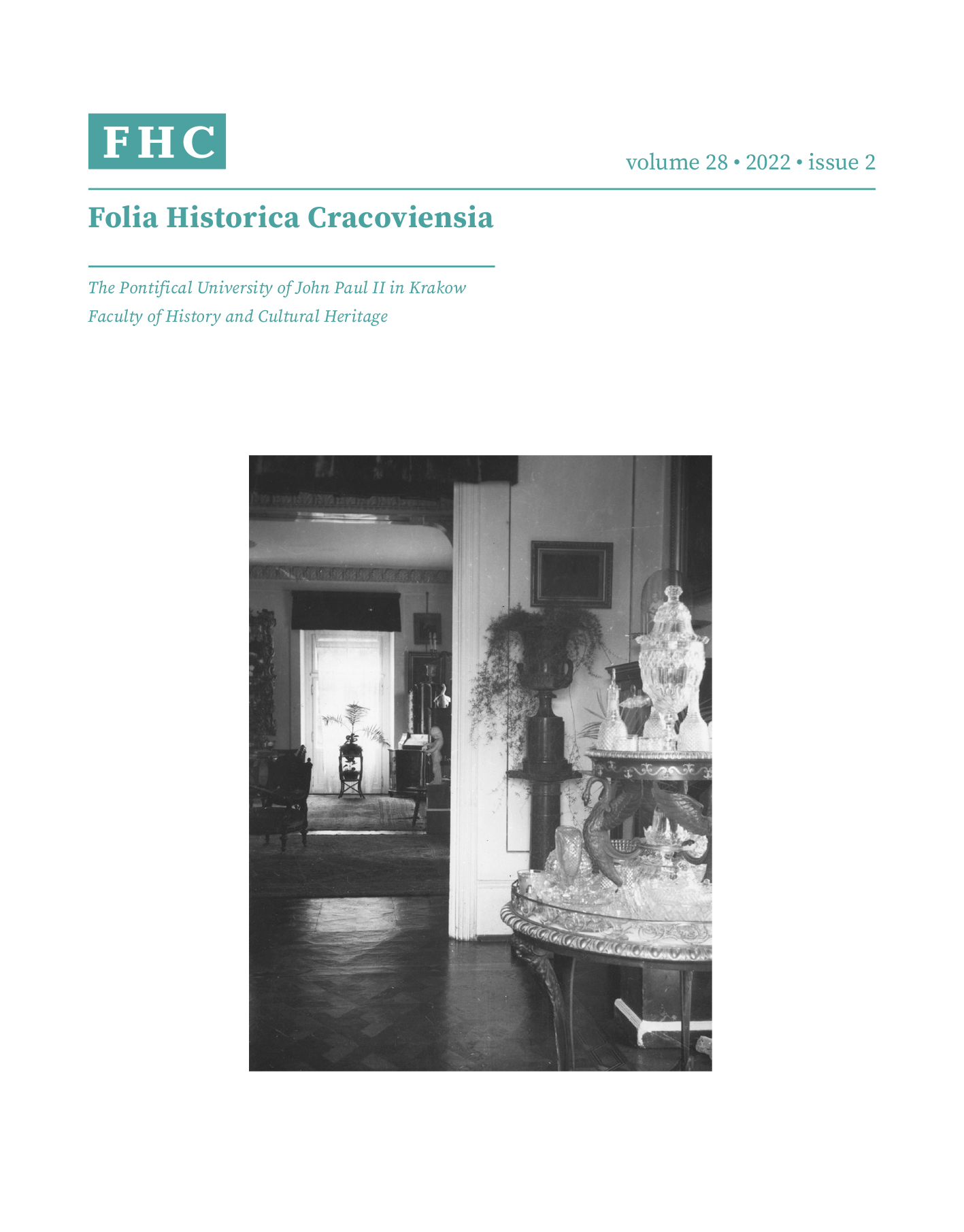Medieval fabrics with eastern provenience in Polish collections
DOI:
https://doi.org/10.15633/fhc.28202Keywords:
textiles, silk, merchant, Orient, artisticAbstract
Textiles produced in the leading weavers’ centres of the Orient and used in Poland during the Middle Ages make an interesting and valuable complex. They were imported mainly for liturgical vestments but also for decoration of chapels and secular interiors. Richly and uniquely designed, woven in specialized workshops from silk with large amount of gold, they demonstrated prestige and taste of the ecclesiastical and secular elites. Eastern textiles in Polish collections may be combined in separate groups. The first group, perhaps the most uniform in style and technique, comprises textiles whose origin is attributed to the workshops in Cyprus and Cairo, active under the Mamluc Sultanate (1250–1517), especially in the period 1250–1382. The second group are the textile produced in Constantinople or Brusa before 1449. Another group comprises paraments made of textiles whose pattern includes a rhythmically repeated Arabic inscription stored at National Museum in Gdańsk and coming from the store of the St Mary’s Church in Gdańsk, produced in workshops of northern Persia around the middle of the 14th century.
References
Alexandrowicz S., Stosunki handlowe polsko-ruskie do roku 1240, Poznań 1958 (Zeszyty Naukowe Uniwersytetu im. Adama Mickiewicza w Poznaniu, 3).
Baker P. L., Islamic Textiles, Londyn 1995.
Biedrońska-Słotowa B., Early 15th Century Byzantine and Mamluk Textiles from Wawel Cathedral, Cracow, „Bulletin du CIETA” (1994) No. 72, pp. 13—19.
Biedrońska-Słotowa B., Bliskowschodnie tkaniny liturgiczne i ich rola w katedtrze na Wawelu w czasach biskupa Zbigniewa Oleśnickiego, in: Sztuka około 1400. Materiały sesji Stowarzyszenia Historyków Sztuki, t. 2, listopad 1995,ed. by T. Hrankowska, Poznań—Warszawa 1996, pp. 249—254.
Biedrońska-Słotowa B., Orient w sztuce polskiej, Kraków 1992.
Bochnak A., Groby królowej Jadwigi i królewicza Kazimierza Jagiellończyka w katedrze Wawelskiej, Kraków 1968 (Studia do Dziejów Wawelu, 3).
Burkiewicz Ł., Polityka egipskiego sułtanatu Mameluków wobec łacińskiego królestwa Cypru w XV wieku, „Zeszyty Naukowe Towarzystwa Doktorantów Uniwersytetu Jagiellońskiego — Nauki Społeczne” (2011) nr 2 (1/2011), s. 7—22.
Chrzanowski T., Kornecki M., Sztuka ziemi krakowskiej, Kraków 1982.
Durian-Ress S., Meisterwerke mittelterlicher Textilkunst aus dem Bayerischen Nationalmuseum, Zurich 1986.
Falke O., Kunstgeschichte der Seidenwebereien, Berlin 1913.
Hinz A., Die Schatzkammer der Marienkirche zu Danzig, Danzig 1863.
Jacoby D., Oriental Silk at the Time of the Mongols: Patterns of Trade and Distribution in the West, in: Oriental Silks in Medieval Europe, eds. J. Fircks, R. Schorta, Abbeg—Stiftung 2016, pp. 92—123.
Jażdżewski K., Stosunki polsko-ruskie we wczesnym średniowieczu w świetle archeologii, „Pamiętnik Słowiański” 4 (1954) No. 2, pp. 340—360.
Karabacek J., Die liturgischen Gewander mit arabischen Inschriften aus der Marienkirche in Danzig, No. 5, Wien 1870.
Lessing J., Die Gewebesammlung des K.Kunstgewerbemuseums, Berlin 1900.
Mannowsky W., Kirchliche Gawander und Stickereien aus dem Schatz der Marienkirche, Danzig 1929.
Mannowsky W., Der Danziger Paramentenschatz, vol. 2, Berlin 1930—1933.
Monnas L., The Impact of Oriental Silks on Italian Silk Weaving in the Fourteenth Century, in: The Power of Things and the Flow of Cultural Transformations Art and Culture between Europe and Asia, Berlin 2010.
Rybakow B., Torgowlja i torgowye puti, in: Istorija kultury drewnej Rusi, vol. 1, ed. by N. Woronin, Moskwa 1948.
Rosatti M. L., „De opera curioso minute”. The Vestments of Benedict XI in Perugia and the Fourteenth Century Perceptions of “Panni Tartarici”, in: Oriental Silks in Medieval Europe, Abbeg—Stiftung 2016.
Walczak M., Działalność fundacyjna biskupa krakowskiego kardynała Zbigniewa Oleśnickiego, „Folia Historiae Artium” 28 (1992),
pp. 57—73.
Wardwell A. E., Indigenous elements in Central Asian Silk designs of the Mongol Period, and their impact on Italian gothic silks, “Bulletin CIETA” (2000) No. 77, pp. 86—98.
Watt C.Y., Wardwell A. E., When the Silk was Gold, New York 1997.
Wawel 1000—2000, Wystawa Jubileuszowa: Kultura artystyczna dworu królewskiego I katedry. Katedra Krakowska — biskupia, królewska, narodowa, ed. by M. Piwocka, D. Nowacki, Kraków 2000.
Żarnowiecki L., Historya tkanin jedwabnych, Kijev 1915.
Żelewska M., Wystawa gdańskiego zbioru tkanin zabytkowych, Warszawa—Poznań 1964.
Zelewska M., Gdański zbiór tkanin średniowiecznych, Gdańsk 1966.
Downloads
Published
Issue
Section
License

This work is licensed under a Creative Commons Attribution 4.0 International License.
Authors who publish with this journal agree to the following terms:
- Authors retain the copyright and full publishing rights without restrictions, and grant the journal right of first publication with the work simultaneously licensed under a Creative Commons Attribution 4.0 International License that allows others to share the work with an acknowledgement of the work's authorship and initial publication in this journal.
- Authors are able to enter into separate, additional contractual arrangements for the non-exclusive distribution of the journal's published version of the work (e.g., post it to an institutional repository or publish it in a book), with an acknowledgement of its initial publication in this journal.
- Authors are permitted and encouraged to post their work online (e.g., in institutional repositories or on their website) prior to and during the submission process, as it can lead to productive exchanges, as well as earlier and greater citation of published work (See The Effect of Open Access).

